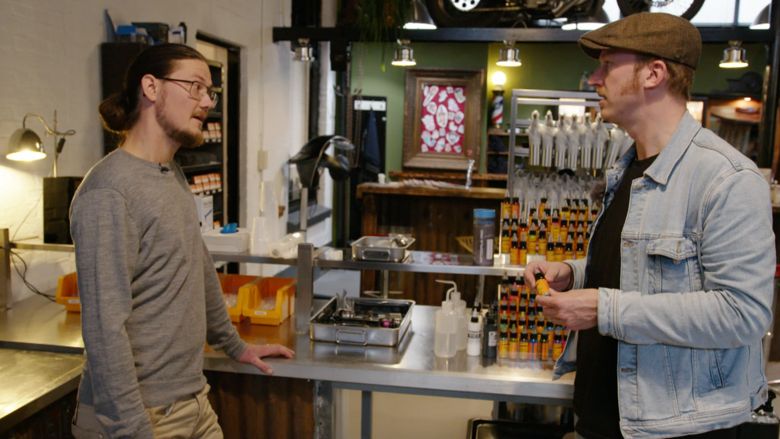What tattoo do I want and where do I want it on my body? Everyone asks these questions when getting a tattoo, but have you ever wondered about the health risks associated with tattooing? There are different types of ink that contain potentially carcinogenic substances.
polycyclic aromatic hydrocarbons, heavy metals, preservatives, azo dyes; All substances that can be in tattoo ink and are carcinogenic. NVWA monitors this material in response to notifications, but can consumers also monitor this themselves?
Even a tattoo artist doesn’t know what’s in their ink
‘It’s almost not possible,’ says Thomas Rustemeyer, professor and dermatologist at Amsterdam UMC. Often the tattoo artist does not know what is inside. Labels are currently public. The rules are clear, but control over them is weak.
Producers have to prove that the ink is safe, and it can be divided into three categories: proven safe, not proven safe, and proven unsafe. ‘The safety of the material in it hasn’t been proven now, but it’s not that safe either,’ says Gerrit Grotenhar, president of the Dutch Branche Tattoo Kunst and owner of the Sailors & Crooks tattoo shop.
The bottom line is that there needs to be an investigation into exactly what the ink does. This task now falls to the producers, because they have to prove that we are allowed to work with their products. But at the moment I have not heard if they are investigating it or not.
new european legislation
In order to provide consumers with more information and better monitor the inks, new European legislation will be introduced on January 1, 2022. The tattoo artist must be able to show the ink label used from that date to the consumer. In addition, the tattoo artist must keep track of the ink he used for each client, NVWA says.
According to NVWA, “It is the supplier’s responsibility to ensure that tattoo pigments comply with the Tattoo Pigments Goods Act Ordinance.”
Tattoo shops are not aware of the new legislation
But is the supplier aware of this? A tour of Fons along several tattoo parlors and suppliers shows that many are not at all familiar with this new legislation. Grutenhar thinks the research into the inks should have been done earlier.
It is possible that a large part of the inks will be blocked suddenly, because whether or not they are carcinogenic has not been proven. So it’s also important for us to do more research on this and not suddenly have to deal with a certain banned ink.
As a trade association, we must be able to count on it being safe. Now there is a danger, because soon you may have to block things and then an underground scene appears. So you really risk using dangerous inks suddenly in the future.
What do we now know about the risks?
The RIVM notes that the risk of developing cancer from tattoos is small, but it cannot be neglected. Numbers about the chance of developing cancer from tattoos vary widely. According to RIVM, this depends on the following factors:
- 30% of the colored inks tested contained azo dyes, of which aromatic amines can be formed, and 41% of the black inks contained polycyclic aromatic hydrocarbons. These inks can release carcinogens. If these substances are released into the body, they increase the risk of cancer.
- UV light from the sun or a tanning bed promotes the formation of aromatic amines. If it is released into the body, this increases the risk of cancer.
- The size of the tattoo, the concentration of the harmful substance, and when your body is exposed to it all play a role in the development of cancer.
- Laser tattoo removal can release carcinogenic substances.
But what is the chance of getting cancer from this ink?
According to Rustemeyer, more research needs to be done. Some studies have been done and a study has shown that a person with a tattoo gets cancer faster – most often it is related to bladder cancer – but these studies are all very weak.
You need a lot of tattooed people for such a study who also got cancer later on. Look at smoking and tobacco, it took decades before it was found to be a carcinogen.
Rustemeyer also researched the inks himself. We found inks that contain hazardous materials. This depends on the color. With black ink, for example, that is made from soot, there is a good chance that it is made of polycyclic aromatic hydrocarbons.
Tattoo shops with a GGD permit
So it is not yet possible to check if your tattoo artist’s inks are safe. Tattoo artists and importers can only provide certainty about safe dyes if their inks have been tested.
However, it is wise to only go to a tattoo artist with a GGD permit. Then you are assured that the tattoo artist is working in a healthy way. In addition, tattooists are likely to use tattoo-safe pigments. On the website Veiligtatoeerenpiercen.nl you can find out which tattoo artists have a permit.
Special research into tattoo bias
Radar mode too private search among the members of the examination committee. More than 7,500 tattoo wearers responded to this and shared their experiences of prejudice, social exclusion, positive feedback and possibly tattoo removal.

“Coffee buff. Twitter fanatic. Tv practitioner. Social media advocate. Pop culture ninja.”











More Stories
Which can cause an increase in nitrogen.
The Central State Real Estate Agency has no additional space to accommodate Ukrainians.
The oystercatcher, the “unlucky national bird,” is increasingly breeding on rooftops.